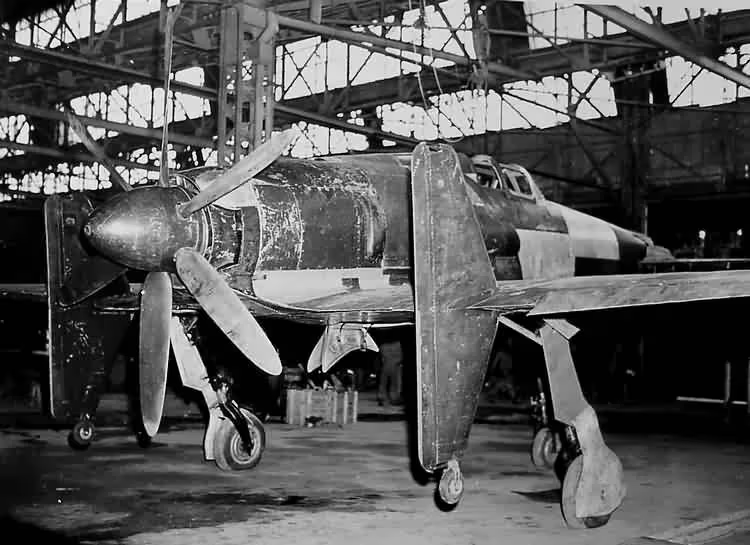Warplanes of Japan: Kyushu J7W1 Shinden
Kyushu J7W1 Shinden

(IJAAF Photo)
Kyushu J7W1 Shinden.
The Kyūshū J7W Shinden(震電,"Magnificent Lightning") is a Second World War Japanesepropeller-driven prototype fighter plane with wings at the rear of thefuselage, a nose-mounted canard, and a pusher engine.
Developed by the Imperial Japanese Navy (IJN) as a short-range, land-basedinterceptor, the J7W was a response to Boeing B-29 Superfortress raids on theJapanese home islands. For interception missions, the J7W was to be armed withfour forward-firing 30 mm type 5 cannons in the nose.
The Shinden was expected to be a highly maneuverable interceptor, but only twoprototypes were finished before the end of the war. A jet engine–poweredversion was considered, but never reached the drawing board.
In the IJN designation system, "J" referred to land-based fightersand "W" to Watanabe Tekkōjo, the company that oversaw the initialdesign.
The idea of a canard-based design originated with Lieutenant CommanderMasayoshi Tsuruno, of the technical staff of the IJN in early 1943. Tsurunobelieved the design could easily be retrofitted with a turbojet, when suitableengines became available. His ideas were worked out by the First Naval AirTechnical Arsenal (Dai-Ichi Kaigun Koku Gijitsusho), which designed threegliders designated Yokosuka MXY6, featuring canards. These were built byChigasaki Seizo K. K. and one was later fitted with a 22 hp Semi 11 (Ha-90)4-cylinder air-cooled engine.
The feasibility of the canard design was proven by both the powered and unpoweredversions of the MXY6 by the end of 1943,[7] and the Navy were so impressed bythe flight testing, they instructed the Kyushu Aircraft Company to design acanard interceptor around Tsuruno's concept. Kyushu was chosen because both itsdesign team and production facilities were relatively unburdened,[7] andTsuruno was chosen to lead a team from Dai-Ichi Kaigun Koku Gijitsusho to aidKyushu's design works.
The construction of the first two prototypes started in earnest by June 1944,stress calculations were finished by January 1945,[8] and the first prototypewas completed in April 1945. The 2,130 hp Mitsubishi MK9D (Ha-43) radial engine and its supercharger were installed behind the cockpit and drove a six-bladedpropeller via an extension shaft. Engine cooling was to be provided by long,narrow, obliquely mounted intakes on the side of the fuselage.[9] It was thisconfiguration that caused cooling problems while running the engine while itwas still on the ground. This, together with the unavailability of someequipment parts postponed the first flight of the Shinden.
Even before the first prototype took to the air, the Navy ordered the J7W1 intoproduction,[9] with a quota of 30 Shinden a month given to Kyushu'sZasshonokuma factory and 120 from Nakajima's Handa plant.[9] It was estimatedsome 1,086 Shinden could be produced between April 1946 and March 1947.
On 3 August 1945, the prototype first flew, with Tsuruno at the controls, fromMushiroda Airfield. Two more short flights were made, a total of 45 minutesairborne, one each on the same days as the atomic bombings of Hiroshima andNagasaki occurred, before the war's end. Flights were successful, but showed amarked torque pull to starboard (due to the powerful engine), some flutter ofthe propeller blades, and vibration in the extended drive shaft.
Surviving aircraft
The two prototypes were the only examples of the Shinden ever completed. Afterthe end of the war, one was scrapped; the other was claimed by a U.S. NavyTechnical Air Intelligence Unit in late 1945, dismantled, and shipped to theUnited States.
The sole surviving J7W1 was reassembled, but has never been flown in the UnitedStates; the USN transferred it to the Smithsonian Institution in 1960.[13] Itsforward fuselage is currently on display at the Steven F. Udvar-Hazy Centerannex (at Dulles Airport) of the National Air and Space Museum in WashingtonDC. According to the NASM, 'miscellaneous parts' are stored at Building 7C atthe older storage/annex facility, the Garber Facility in Suitland, Maryland.
A full-scale replica of the Shinden built for the filming of Godzilla Minus Oneon display at the Tachiarai Peace Memorial Museum
A 1:1 scale model of the J7W1, built by a then-unknown production company, wasunveiled at the Tachiarai Peace Memorial Museum in July 2022. The company waslater revealed to be Toho Studios, with the scale model being made for theproduction of Godzilla Minus One (2023). (Wikipedia)







(USAAF Photos)
Kyushu J7W1 Shinden, found at the factory where it was built in Japan in 1945. One J7W1 Shinden was shipped to the USA, USAAF FE-326. This aircraft is preserved in the Smithsonian Institution.

(Yagyu8 Photo)
A full-scale replica of the Shinden built for the filming of Godzilla Minus One on display at the Tachiarai Peace Memorial Museum.





